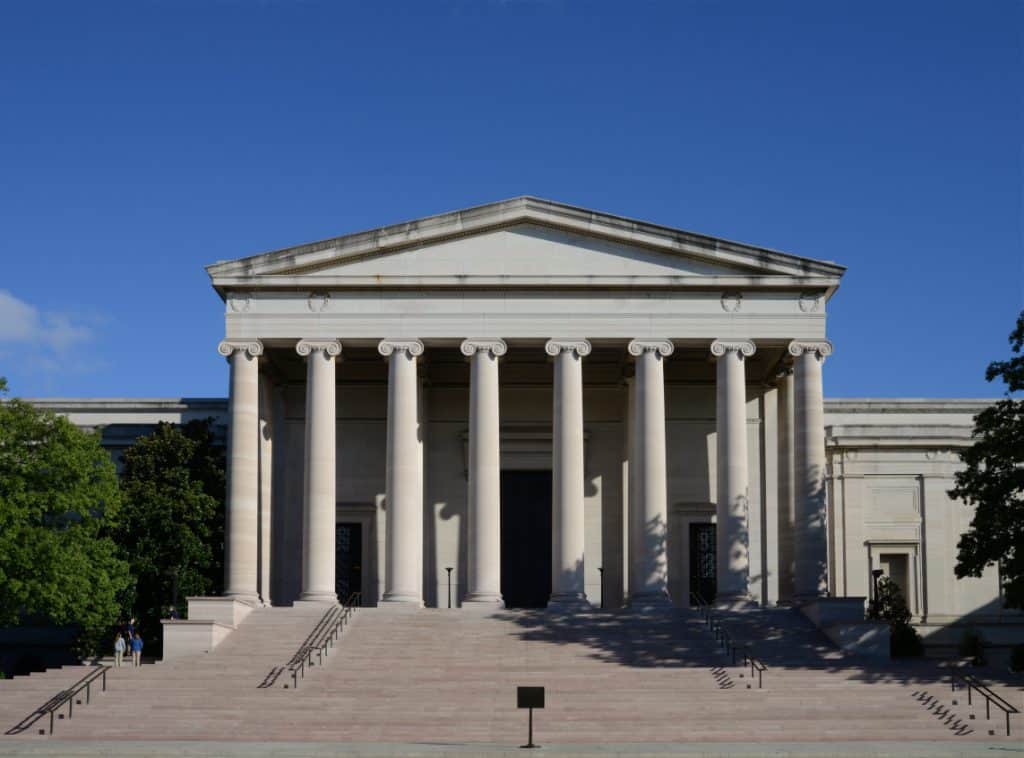Museum MOOCs Designed for Teachers
How MOOCs created by museums can help K12 teachers and achieve high engagement numbers.

My recent articles examined how teachers of all levels and topics seek to improve on their practices by enrolling in MOOCs, and what MOOC-makers might do to support teachers as MOOC learners. My final article in this series interviews museum staff members who make MOOCs specifically for Teacher Professional Development (TPD). As educational institutions that earn a very high degree of public trust, museums use a variety of public online platforms to share authoritative collection information and research widely. Many museum-made MOOCs focus on K12 teachers as learners and address current challenges in teaching practices. Read on to find out why and how these online courses help K12 teachers and earn museum MOOCs high engagement numbers.
From Museum Galleries to Classrooms
The National Gallery of Art (“the Gallery”) in Washington, DC has a long history of offering extensive TPD opportunities and K12 resources, including strategies for integrating art across the curriculum. The Gallery museum educators Sara Lesk and Julie Carmean design TPD workshops based on pedagogy developed by Project Zero at the Harvard Graduate School of Education Called Artful Thinking routines. These strategies encourage teachers to use open-ended questions to promote conversations about art as a way to improve students’ critical thinking. When onsite workshop attendees asked for technique videos to support their classroom practice, Lesk and Carmean designed an interactive, learner-centered MOOC. Launched on the edX platform in January 2019, Teaching Critical Thinking through Art with the National Gallery of Art is a free, five-week course featuring Carmean, a former classroom teacher, along with other museum and classroom educators, demonstrating how any teacher can use paintings and sculptures as exciting points of departure for group discussions rooted in close observation, reasoning with evidence, and lively debate.
The Gallery is delighted with how well teachers engage with their first MOOC. Carmean reports:
“In the first six months, more than 7,000 people–43% identifying as classroom teachers and representing 146 countries–enrolled. Over 70% of our active learners watch our course videos from beginning to end! And especially gratifying is to read the in-depth discussion forum conversations and review the thoughtful practice assignments uploaded into the course, which document student thinking. Teachers take the MOOC’s online learning community very seriously and are willing to invest time and goodwill in participating and responding to each other.”
Other museums report similar high engagement results from their TPD MOOCs. The Museum of Modern Art (MoMA) was an early MOOC-maker, offering three TPD courses on the Coursera platform, including Art and Activity attracting over 60,000 enrollments since launching 5 years ago. Lisa Mazzola directs MoMA’s school and teacher programs and is one of the online course instructors:
“The mindset and motivation of the teachers that we have seen online and globally aligns very closely to what we have experienced in our onsite programs. Teachers are passionate and motivated about learning and providing quality experiences for their students. They are also open to engaging in conversation about pedagogy and content in online discussion forums”
MoMA is particularly proud of the 60% completion rates for certificate (i.e., paid) enrollment in their 3 TPD courses, likely related to the value teachers derive from earning the Coursera certification, according to MoMA educator Kelly Cannon who manages MOOC production. Depending on local regulations, school systems and/or union rules, proof of MOOC completion can translate into evidence of professional development towards career advancement and therefore provides a compelling incentive for certificate completion.
What About Science Museums?
The American Museum of Natural History (AMNH) was another early adopter on Coursera, and 2 of its 6 MOOCs are especially designed for TPD. Rob Steiner directs online education at AMNH and observes that teachers use MOOCs to “deepen their understanding of science, of the process of scientific investigation and the ability to acquire digital classroom resources for the benefit of their students.” AMNH gives teachers authoritative and compelling classroom resources on such timely topics as the evolution of species and the dynamic nature of the earth’s environment. AMNH staff are able to borrow videos and media content from museum exhibition elements as well as their other online courses and degree programs which allows the AMNH to provide a rich, immersive experience in a cost effective way.
The Exploratorium in San Francisco is celebrating 50 years of changing how we think about science and helping teachers harness the power of learning by doing. Luigi Anzivino leads professional development programs for the Tinkering Studio and confirms their success reaching teachers via MOOCs:
“We have been pleasantly surprised by the thoughtful and supportive community that has formed and keeps forming in the discussion forums, where teachers have rich conversations around tinkering from both a pedagogical and practical point of view. We’ve even seen teachers come together in person in small groups to take the class together and go through the exercises, and this aspect of serving as a connection between teachers that might not otherwise have found each other is one of the most satisfying of this endeavor.”
The Future of Teachers, Museums, and MOOCs?
The secret of the museum MOOC sauce is that 1. makers are pushing existing platforms to be better, more engaging learning experiences and 2. teachers are responding and connecting not only with the course content but most importantly with each other. What more could be done to help both the deserving teachers–so often constrained by limited time and resources–as well as all the MOOC makers to attract more enrollees and improve their service to teachers? Below are the top three directions suggested by the interviewees:
- Design a unified credit system for MOOC participation that all education administrations recognize. These TPD MOOC makers remarked that teachers need the flexibility of MOOC-based learning and will pay for enrollment when their supervisors understand and value these online educational experiences, as evidenced by the MoMA example above. More could be done by MOOC platforms to advocate at national, local and community levels for a structured credit system that reflects the achievement levels of the enrolled teachers and builds towards their career advancement. It goes without saying that incentivising teachers to purchase certificates and other microcredentials will also benefit the sustainability of MOOC-makers as well. In other parts of the world, education systems are moving rapidly towards online course platforms for teacher certification, upskilling, and credentialing. This trend is as true for large government-led systems like those in India, with an overwhelming and under-resourced education mandate, as it is for small, university-powered K12 networks like those in Scotland that look to use MOOCs for connecting their place-bound and remotely located teachers with each other, as well as to experts all around the world.
- Transform the online course platforms to more easily support immersive, non-linear and hands-on learning. Most MOOC platforms were invented by universities and therefore support traditional academic habits e.g., linear progressions of one-way information transmission, organized by topics and time segments. But what if MOOC platforms were designed by museums? The learning process would likely reflect a more student-centered experience, where learning paths would follow individual content interests, and deep dives would be supported with hands-on and other immersive opportunities. Achievement could be measured by how enrollees apply their new knowledge in actual or virtual settings. This student-centered learning revolution is transforming on-ground educational practice from K12 to Higher Ed: why should MOOCs not follow suit? Museums are natural leaders in informal education practices like these, which is a key reason why teachers depend on them for professional development. As we saw in the above Gallery example, the expertise in attracting and holding visitors with exciting educational methods and materials is directly related to higher than normal engagement numbers.
- Collaborate with teachers to be partners in online learning innovations. Carmean of the Gallery envisions organizing successful MOOC takers as mentors for the newly-enrolled, perhaps in cohorts in order to frame the collective endeavor into learning cycles. Anzivino of the Exploratorium observes this self-organized, group learning experience occurring naturally in his courses and would love to see more. The Canvas platform invites teachers to create their own MOOCs for free and hopes to learn from these practitioner-driven experiments.
Imagine a global community of teachers–stretching across 193 countries from Scotland to India, Australia and Canada–participating in innovation workshops around the real needs and challenges of educating tomorrow’s leaders. It is breathtaking to envision the power of such a well-connected and mission-motivated group to help MOOC-makers design the next best platforms! And teachers collaborating with authoritative content specialists such as universities and museums can transform online learning into an even more exciting, relevant, and social experience, one that engages you beyond a single course and throughout your life-long learning path.
Deborah Howes is president of Howes Studio Inc, a consulting practice offering planning, production and evaluation services, and specializing in teaching via digital tools and platforms. Disclosure: Howes Studio Inc. co-produced the MOOC Teaching Critical Thinking through Art with the National Gallery of Art.
Many thanks to:
Julie Carmean, Manager of National Teacher Programs at the National Gallery of Art in Washington, D.C, together with Sara Lesk, Senior Educator & Manager of Art Around the Corner. They recently launched the online course Teaching Critical Thinking through Art with the National Gallery of Art, on the edX platform in collaboration with SmithsonianX.
Lisa Mazzola, Assistant Director, School and Teacher Programs and Kelly Cannon, Associate Educator, Interpretation, Research and Digital Learning who collaborate on producing MOOCs for the Museum of Modern Art on the Coursera platform.
Rob Steiner, PhD, Director of Online Education at the American Museum of Natural History, and Luigi Anzivino, Professional Development lead at Exploratorium who both create and oversee science-related MOOCs for teachers on the Coursera platform.
Tags






